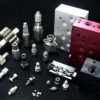Former X (NASDAQ: TWTR) CEO Jack Dorsey may have cracked the code on a new Bitcoin mining chip that could theoretically decentralize both bitcoin mining hardware and the way hashrate is distributed.
Dorsey’s tech company, Block, made the announcement on Sunday in a blog post, saying that it completed the development of its three-nanometer mining chip, which has been in production since April 2023. The design now moves onto its next stage with a global semiconductor foundry.
Block first announced that had been working on a new Bitcoin mining hardware in an October tweet to decentralize both the supply of bitcoin mining hardaare and hashrate distribution.
The next move, according to Block, is to develop a full bitcoin mining system and system design after a lengthy palaver with community members regarding negative experiences in the industry.
“We’ve spent a significant amount of time talking to a wide variety of bitcoin miners to identify the challenges faced by mining operators,” the post said.
“Building on these insights and pursuant to our goal of supporting mining decentralization, we plan to offer both a standalone mining chip as well as a full mining system of our own design.”
Beijing-based miner Bitmain dominates the bitcoin mining industry, controlling approximately 60 per cent of the market, according to CoinShares estimates.
James Butterfill, the head of research at CoinShares, suggests that the lack of serious competitors presents a significant opportunity for market disruption. In May 2023, Block completed a prototype of a five-nanometer bitcoin mining chip, which employs the same technology as Bitmain’s S21 mining machine.
Read more: DMG Blockchain Solutions, PayPal and Energy Web collaborate to clean up Bitcoin blockchain
Read more: Netcoins adds four memecoins to growing list of 45 crypto assets
Advancement aimed to help miners thrive in the fifth mining epoch
Butterfill believes this advancement suggests that chips as small as 3nm could be even more efficient. The recent halving event on April 20, which reduced the issuance of new bitcoin by 50 per cent, has increased the importance of faster mining speeds, cost reduction, and enhanced reliability, especially as chip efficiency has significantly improved in response to rising bitcoin demand.
According to the report, most bitcoin mining ASICs available on the market today use five-nanometer technology, which was the focus of Block’s initial development efforts. Over the past year, the company completed the design of a high-performing bitcoin mining ASIC on this five-nanometer semiconductor node. Originally, it planned to complete a full tape out of this design within this quarter.
However, during planning for the tape out, Block discovered an opportunity to purchase a large volume of bitcoin mining ASICs from Intel. It had just finalized a purchase agreement with Intel. This acquisition provided them with immediate access to production ASICs, and the company used that to accelerate its mining system development and enabling it to enter the market more quickly.
Now that Block has successfully completed the chip design, it states that this chip demonstrates competitive performance by using the most advanced semiconductor process currently available.
This advancement ensures that mining operators of all types can thrive in the fifth mining epoch following the fourth halving of the Bitcoin blockchain. Keeping with its goals of mining decentralization, Block intends to offer both a standalone mining chip and a full mining system.
The company claims that their standalone chip will position Block as the only large, well-capitalized mining hardware vendor offering such a solution, which will encourage innovation and new use cases in the mining industry.
.
Follow Joseph Morton on Twitter
joseph@mugglehead.com













